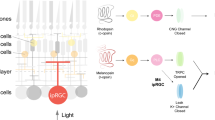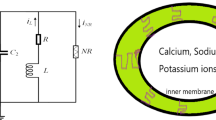Summary
-
1.
In order to describe stimulus-response relationships for retinal ganglion cells a mathematical formulation is presented on the basis of experimental data and some simple assumptions. This concept involves two mechanisms — an excitatory and an inhibitory one — both extending over the whole receptive field.
-
2.
The following formula
$$S\left( I \right) = \frac{{c{\text{ }}{I \mathord{\left/ {\vphantom {I {I_S - 1}}} \right. \kern-\nulldelimiterspace} {I_S - 1}}}}{{1 + a{\text{ }}a{I \mathord{\left/ {\vphantom {I {I_S + 1}}} \right. \kern-\nulldelimiterspace} {I_S + 1}}}}$$is used for description of the excitatory responses (on-response for on-center neurones, off-response for off-center neurones). The value ofa depends on the area of light stimulation,c is a constant;I/I S designates the ratio of stimulus brightness to threshold brightness.
-
3.
Thresholds and suprathreshold response curves for concentric stimuli are described quantitatively by the formula. The experimental data were obtained by computer counts of spike discharges during 200 and 500 ms following the exciting light increment or decrement.
-
4.
Ricco's, Weber-Fechner's and Stevens's laws are included in our conception as approximations of neuronal summations. These relations are limited to certain stimulus ranges; in contrast the above response function saturates at certain maximum discharge rates, as found by the S-shaped experimental curves; thus the formula is valid over the whole range of stimulation from threshold to very high intensities.
-
5.
Thresholds as well as excitatory and inhibitory effects depend on background illumination and stimulus parameters. Therefore, center and surround size depend on these factors.
-
6.
The formulation is set up for stationary responses and consequently does not describe time dependent characteristics.
-
7.
Within these limits on-center and off-center neurones appear to have identical stimulus-response functions for adequate stimuli. Since in our experiments light increments and decrements were not symmetrical with respect to background illumination, a factor of 2 had to be introduced corresponding to the lower discharge rates of off-center-neurones.
Similar content being viewed by others
Literatur
Bekesy, G.: J. opt. Soc. Amer.50, 1060 (1960).
Bishop, P. O., Rodieck, R. W.: Symposion on Information Processing in Sight Sensory Systems 1965, Pasadena, Calif.
Brown, J. E.: J. Neurophysiol.28, 1091 (1965).
—, Major, D.: Exp. Neurol.15, 70 (1966).
Büttner, U., Grüsser, O. J.: Kybernetik4, 81 (1968).
Campbell, F. W., Cooper, G. F., Enroth-Cugell, C.: J. Physiol. (Lond.)203, 223 (1969).
Creutzfeldt, O., Sakmann, B., Scheich, H.: Kybernetik4, 239 (1968).
Enroth-Cugell, C., Robson, J. G.: J. Physiol. (Lond.)187, 517 (1966).
Freund, H.-J., Grünewald, G.: Exp. Brain Res.8, 37 (1969).
Fry, G. A.: J. opt. Soc. Amer.53, 94 (1963).
Furman, G. G.: Kybernetik2, 257 (1965).
Grüsser, O. J.: Personal Communication.
Hagiwara, S., Tasaki, J.: J. Physiol. (Lond.)148, 114 (1958).
Hartline, H. K.: Amer. J. Physiol.121, 400 (1937).
— Ratliff, F.: J. gen. Physiol.41, 1049 (1958).
Huggins, W. H., Licklider, J. C. R.: J. acoust. Soc. Amer.23, 290 (1951).
Kuffler, S. W.: J. Neurophysiol.16, 37 (1953).
Lange, G. D., Hartline, H. K., Ratliff, F.: In: The functional organisation of the compound eye, ed. C. G. Bernhard, p. 425. New York: Pergamon Press 1966.
Mach, E.: S.-B. Akad. Wiss. Wien, math.-nat. Kl.54, 393 (1866).
May, H. U., Fischer, B.: In Vorbereitung.
Rodieck, R. W., Stone, J.: J. Neurophysiol.28, 833 (1965).
Taylor, W. K.: In: Information Theory (Colin Cherry, ed.). New York: Academic Press 1956.
Werner, G., Mountcastle, V. B.: J. Neurophysiol.28, 359 (1965).
Wiesel, T.: J. Physiol. (Lond.)153, 583 (1960).
Wita, C., Freund, H.-J.: Symp. BiokybernetikII, 1969, Leipzig.
Wuttke, W., Rackensperger, W., Grüsser, O J.: Pflügers Arch. ges. Physiol.283, R 49 (1965).
Author information
Authors and Affiliations
Rights and permissions
About this article
Cite this article
Fischer, B., Freund, HJ. Eine mathematische Formulierung für Reiz-Reaktionsbeziehungen retinaler Ganglienzellen. Kybernetik 7, 160–166 (1970). https://doi.org/10.1007/BF00571696
Received:
Issue Date:
DOI: https://doi.org/10.1007/BF00571696




